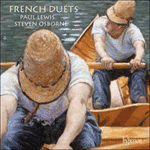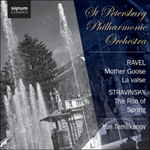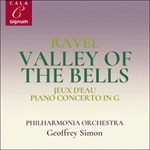
Welcome to Hyperion Records, an independent British classical label devoted to presenting high-quality recordings of music of all styles and from all periods from the twelfth century to the twenty-first.
Hyperion offers both CDs, and downloads in a number of formats. The site is also available in several languages.
Please use the dropdown buttons to set your preferred options, or use the checkbox to accept the defaults.

It was for these two children that Ravel wrote the original piano-duet version of Ma mère l’oye, hoping they would give the first performance. But in the end, two other children gave the suite its first performance in April 1910. In the ‘Pavane of the sleeping beauty’, Ravel wanted a very slow tempo and simple playing without looking to make every note expressive. The story of ‘Petit poucet’ (Tom Thumb) tells how he left a trail of breadcrumbs to guide him on his way back through the forest, but the birds ate them up. The smooth thirds, on strings—which have to be very uniform in sonority—in Ravel’s own orchestration, depict his journey, and the variable time signatures his hesitations.
In ‘Laideronnette, empress of the pagodas’, Ravel turned understandably to the pentatonic scale, although the pagodas in question are not in fact Chinese temples but small, insect-like creatures who make music with nutshells. There are clear similarities between some of the textures and Debussy’s ‘Pagodes’ (from Estampes), and also with the oriental gamelan music Ravel heard at the Paris Exhibition of 1889.
The contrast in ‘Beauty and the beast’ between the two main characters is achieved simply in this piano-duet version by allotting each of them to one of the two performers. Here Ravel seems to pay homage to Satie’s Gymnopédies. Finally, in ‘The magic garden’, we find one of the most potent evocations of the nostalgia Ravel felt for his own childhood. Style (manière) simplified; means of expression (écriture) refined. The precise matching of the limitations of manière with those of écriture is undoubtedly one of the things that makes this suite a masterpiece.
from notes by Roger Nichols © 2021
C’est pour ces deux enfants que Ravel écrivit la version originale pour piano à quatre mains de Ma mère l’oye, espérant qu’ils en donneraient la première exécution. Mais, en fin de compte, ce sont deux autres enfants qui s’en chargèrent en avril 1910. Dans la «Pavane de la belle au bois dormant», Ravel voulait un tempo très lent et un jeu simple sans chercher à rendre chaque note expressive. L’histoire du «Petit poucet» raconte comment il laissa tomber sur le chemin des petites miettes de pain pour retrouver le chemin du retour à travers la forêt, mais les oiseaux les mangèrent toutes. Les tierces douces—dont la sonorité doit être très uniforme—dépeignent son cheminement, et les changements de mesure ses hésitations.
Dans «Laideronnette, impératrice des pagodes», Ravel se tourna naturellement vers la gamme pentatonique, bien que les pagodes en question ne soient pas en fait des temples chinois mais de petites créatures comme des insectes qui font de la musique avec des coquilles de noix. Il y a des similitudes évidentes entre certaines textures et «Pagodes» (d’Estampes) de Debussy, et aussi avec la musique orientale de gamelan que Ravel avait entendue à l’Exposition universelle de Paris en 1889.
Dans «La belle et la bête», le contraste entre les deux principaux personnages est obtenu simplement dans sa version pour piano à quatre mains en attribuant chacun d’entre eux à l’un des deux interprètes. Ici, Ravel semble rendre hommage aux Gymnopédies de Satie. Finalement, dans «Le jardin féerique», on trouve l’une des plus fortes évocations de la nostalgie que Ravel ressentit pour sa propre enfance. Style («manière») simplifié; moyen d’expression («écriture») raffiné. L’appariement précis des limites de la «manière» avec celles de l’«écriture» est indubitablement l’une des choses qui font de cette suite un chef-d’œuvre.
extrait des notes rédigées par Roger Nichols © 2021
Français: Marie-Stella Pâris
Eben für diese beiden Kinder komponierte Ravel die ursprüngliche Version von Ma mère l’oye für Klavier zu vier Händen, in der Hoffnung, dass sie die erste Aufführung geben würden. Letztendlich wurde die Suite aber von zwei anderen Kindern im April 1910 uraufgeführt. In der „Pavane des Dornröschen“ wollte Ravel ein sehr langsames Tempo und schlichtes Spiel, bei dem nicht jeder Ton expressiv aufgefasst werden sollte. In der Geschichte des „Petit poucet“ („Der kleine Däumling“) wird erzählt, dass die Brotkrumen, die er auf dem Weg in den Wald als Spur fallen gelassen hatte, von den Vögeln aufgepickt wurden. Die weichen Terzen—die klanglich ganz ebenmäßig sein müssen—stellen seine Reise dar, und die unterschiedlichen Zeitmaße sein Zögern.
In „Laideronnette, Kaiserin der Pagoden“ wandte Ravel sich verständlicherweise der pentatonischen Tonleiter zu, obwohl es sich bei diesen Pagoden nicht um chinesische Tempel handelt, sondern um kleine, insektenartige Geschöpfe, die mit Nussschalen Musik machen. Es ergeben sich hier deutliche Ähnlichkeiten zwischen einigen Texturen und Debussys „Pagodes“ (aus Estampes) sowie zu der orientalischen Gamelan-Musik, die Ravel bei der Pariser Weltausstellung 1889 gehört hatte.
Der Kontrast in „Die Schöne und das Biest“ zwischen den beiden Hauptfiguren wird in dieser Klavierduettversion einfach dadurch erreicht, dass sie jeweils einem Spieler zugeordnet werden. Hier scheint Ravel Saties Gymnopédies Tribut zu sollen. Schließlich findet sich in dem „Märchenhaften Garten“ eine besonders wirkungsvolle Darstellung der Sehnsucht, die Ravel für seine eigene Kindheit empfand. Der Stil (manière) ist vereinfacht, der Ausdruck (écriture) verfeinert. Die präzise Annäherung der Einschränkungen der manière mit denjenigen der écriture ist zweifellos eines der Elemente, die diese Suite zu einem Meisterstück machen.
aus dem Begleittext von Roger Nichols © 2021
Deutsch: Viola Scheffel
 Debussy & Ravel: Debussy & Ravel for two Debussy & Ravel: Debussy & Ravel for twoA rich programme incorporating two classics of the genre, several less well known arrangements of Debussy (including by Dutilleux and Ravel, no less) and culminating in Ravel's riotous 'La valse', heard here in the two-piano version which came bef ...» More |
 French duets French duetsA bewitching programme of music often associated with childhood, including favourites by Fauré, Ravel and Debussy; works which amply reward the care lavished on them by Paul Lewis and Steven Osborne in these exquisite accounts.» More |
 Ravel: Mother Goose & La valse; Stravinsky: The Rite of Spring Ravel: Mother Goose & La valse; Stravinsky: The Rite of SpringContrasting pieces by two masters of orchestral composition, these live performances capture the energy and movement of three much-loved balletic works; Ravel's intricate vignettes of childrens' stories in Mother Goose and 'choreographic poem' La ...» More |
 Ravel: Valley of the bells & other orchestral works Ravel: Valley of the bells & other orchestral worksThe piano concerto and 'Rapsodie espangole' are two of the surprisingly few works for orchestra by Ravel which did not start life as piano pieces. This collection also includes the composer's own masterful orchestrations of 'Mother Goose' and two ...» More |

